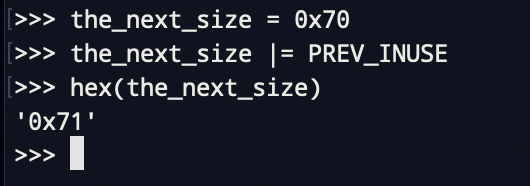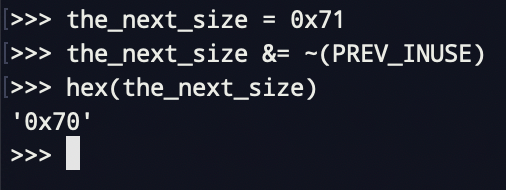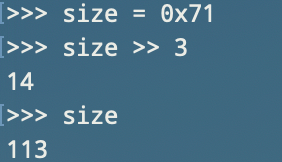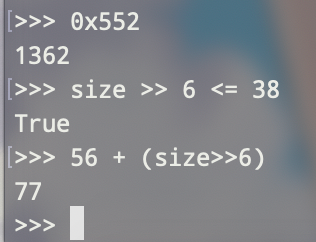更新中
在Linux平台下做漏洞利用的时候,针对于Heap部分总是有些不求甚解,下面开个博文来记录下《Glibc内存管理:ptmalloc2源代码分析》这本书的读后感和收获,一些简单的点将不再记录
说明,本博文中所有的实验均在Linux Ubuntu16.04的环境下进行
目录树:
一些关于计算size的宏
"chunk to mem" and "mem to chunk"
about size
分箱式内存管理
smallbins
largebins
一些关于计算size的宏
Ptmalloc设计的时候很巧妙的一点就是利用宏来屏蔽不同平台的差异,一些简单的细节比如chunk的形式在此我就不再赘述,下面记录一下读后有收获的点
"chunk to mem" and "mem to chunk"
/* conversion from malloc headers to user pointers, and back */
#define chunk2mem(p) ((void*)((char*)(p) + 2*SIZE_SZ))
#define mem2chunk(mem) ((mchunkptr)((char*)(mem) - 2*SIZE_SZ))
about size
MIN_CHUNK_SIZE定义了最小的chunk大小,MINSIZE定义了最小的分配的内存大小,是对MIN_CHUNK_SIZE进行了2*SIZE_SZ对齐,对齐后与MIN_CHUNK_SIZE的大小仍然是一样的
/* The smallest possible chunk */
#define MIN_CHUNK_SIZE (offsetof(struct malloc_chunk, fd_nextsize))
/* The smallest size we can malloc is an aligned minimal chunk */
#define MINSIZE
(unsigned long)(((MIN_CHUNK_SIZE+MALLOC_ALIGN_MASK) & ~MALLOC_ALIGN_MASK))
下面说明一下chunk是如何计算其size的
/* size field is or'ed with PREV_INUSE when previous adjacent chunk in use */
#define PREV_INUSE 0x1
/* extract inuse bit of previous chunk */
#define prev_inuse(p) ((p)->mchunk_size & PREV_INUSE)
/* size field is or'ed with IS_MMAPPED if the chunk was obtained with mmap() */
#define IS_MMAPPED 0x2
/* check for mmap()'ed chunk */
#define chunk_is_mmapped(p) ((p)->mchunk_size & IS_MMAPPED)
/* size field is or'ed with NON_MAIN_ARENA if the chunk was obtained
from a non-main arena. This is only set immediately before handing
the chunk to the user, if necessary. */
#define NON_MAIN_ARENA 0x4
#define SIZE_BITS (PREV_INUSE | IS_MMAPPED | NON_MAIN_ARENA)
/* Like chunksize, but do not mask SIZE_BITS. */
#define chunksize_nomask(p) ((p)->mchunk_size)
/* Get size, ignoring use bits */
#define chunksize(p) (chunksize_nomask (p) & ~(SIZE_BITS))
/* Ptr to next physical malloc_chunk. */
#define next_chunk(p) ((mchunkptr) (((char *) (p)) + chunksize (p)))
/* Size of the chunk below P. Only valid if !prev_inuse (P). */
#define prev_size(p) ((p)->mchunk_prev_size)
比如做个实验来验证下,我们的chunksize为0x71,那么它本身的真实size是如何计算的?
根据宏定义来计算
可以看到计算得出的结果显然正确

下面这一组宏定义用来check/set/clear当前chunk使用标志位,有当前chunk的使用标志位存储在下一个chunk的size的P位,所以下面的宏都要首先算出来下一个chunk的地址
然后再做处理
/* extract p's inuse bit */
#define inuse(p)
((((mchunkptr) (((char *) (p)) + chunksize (p)))->mchunk_size) & PREV_INUSE)
/* set/clear chunk as being inuse without otherwise disturbing */
#define set_inuse(p)
((mchunkptr) (((char *) (p)) + chunksize (p)))->mchunk_size |= PREV_INUSE
#define clear_inuse(p)
((mchunkptr) (((char *) (p)) + chunksize (p)))->mchunk_size &= ~(PREV_INUSE)
我们可以简单来实验一下
define inuse(p) 定义p的inuse

define set_inuse(p) 设置p的inuse位(p的nextchuhnk来设置)

define clear_inuse(p) 清理p的inuse位

下面三个宏用来check/set/clear指定chunk的size域中的使用标志位
/* check/set/clear inuse bits in known places */
#define inuse_bit_at_offset(p, s)
(((mchunkptr) (((char *) (p)) + (s)))->mchunk_size & PREV_INUSE)
#define set_inuse_bit_at_offset(p, s)
(((mchunkptr) (((char *) (p)) + (s)))->mchunk_size |= PREV_INUSE)
#define clear_inuse_bit_at_offset(p, s)
(((mchunkptr) (((char *) (p)) + (s)))->mchunk_size &= ~(PREV_INUSE))
分箱式内存管理
smallbins
smallbins有64个bin,实际共62个bin,bin[0]和bin[1]不存在
chunk_size = 2 * SIZE_SZ * index
范围:16B-504B (32B-1008B)
ptmalloc维护了62个双向环形链表,每个链表都有头节点,便于管理,每个链表内各个空闲的chunk的大小一致
largebins
32:大于等于512B
64:大于等于1024B
一共63个bins
每个bin中的chunk大小不是一个固定公差的等差数列,而是分成6组bin,每组bin是一个固定公差的等差数列
每组的bin数量依次为:32,16, 8, 4, 2, 1
公差依次为: 64,512,4096,32768,262144
可以用数学来描述计算largebins的chunk_size
第一组:chunksize = 512 + 64 * index
第二组:chunksize = 512 + 64 * 32 + 512 * index
……
可以看到,其实smallbins和largebins差不多满足同样的规律,所以可以将small bins和large bins放在同一个包含128个chunk的数组上,数组前一部分为small bins,后一部分为large bins。
每个bin的index是chunk数组的下标,于是,可以根据下标来计算chunk大小(small bins)或者chunk大小范围(large bins)
同样也可以计算所需chunk所属bin的index,ptmalloc使用一组宏来完成计算
宏bin_index(sz)根据所需内存大小来计算出所需bin的index(如果是用户要分配的size,先使用checked_request2size来计算出chunk的大小)
/*
Indexing
Bins for sizes < 512 bytes contain chunks of all the same size, spaced
8 bytes apart. Larger bins are approximately logarithmically spaced:
64 bins of size 8
32 bins of size 64
16 bins of size 512
8 bins of size 4096
4 bins of size 32768
2 bins of size 262144
1 bin of size what's left
There is actually a little bit of slop in the numbers in bin_index
for the sake of speed. This makes no difference elsewhere.
The bins top out around 1MB because we expect to service large
requests via mmap.
Bin 0 does not exist. Bin 1 is the unordered list; if that would be
a valid chunk size the small bins are bumped up one.
*/
#define NBINS 128
#define NSMALLBINS 64
#define SMALLBIN_WIDTH MALLOC_ALIGNMENT
#define SMALLBIN_CORRECTION (MALLOC_ALIGNMENT > 2 * SIZE_SZ)
#define MIN_LARGE_SIZE ((NSMALLBINS - SMALLBIN_CORRECTION) * SMALLBIN_WIDTH)
#define in_smallbin_range(sz)
((unsigned long) (sz) < (unsigned long) MIN_LARGE_SIZE)
#define smallbin_index(sz)
((SMALLBIN_WIDTH == 16 ? (((unsigned) (sz)) >> 4) : (((unsigned) (sz)) >> 3))
+ SMALLBIN_CORRECTION)
#define largebin_index_32(sz)
(((((unsigned long) (sz)) >> 6) <= 38) ? 56 + (((unsigned long) (sz)) >> 6) :
((((unsigned long) (sz)) >> 9) <= 20) ? 91 + (((unsigned long) (sz)) >> 9) :
((((unsigned long) (sz)) >> 12) <= 10) ? 110 + (((unsigned long) (sz)) >> 12) :
((((unsigned long) (sz)) >> 15) <= 4) ? 119 + (((unsigned long) (sz)) >> 15) :
((((unsigned long) (sz)) >> 18) <= 2) ? 124 + (((unsigned long) (sz)) >> 18) :
126)
#define largebin_index_32_big(sz)
(((((unsigned long) (sz)) >> 6) <= 45) ? 49 + (((unsigned long) (sz)) >> 6) :
((((unsigned long) (sz)) >> 9) <= 20) ? 91 + (((unsigned long) (sz)) >> 9) :
((((unsigned long) (sz)) >> 12) <= 10) ? 110 + (((unsigned long) (sz)) >> 12) :
((((unsigned long) (sz)) >> 15) <= 4) ? 119 + (((unsigned long) (sz)) >> 15) :
((((unsigned long) (sz)) >> 18) <= 2) ? 124 + (((unsigned long) (sz)) >> 18) :
126)
// XXX It remains to be seen whether it is good to keep the widths of
// XXX the buckets the same or whether it should be scaled by a factor
// XXX of two as well.
#define largebin_index_64(sz)
(((((unsigned long) (sz)) >> 6) <= 48) ? 48 + (((unsigned long) (sz)) >> 6) :
((((unsigned long) (sz)) >> 9) <= 20) ? 91 + (((unsigned long) (sz)) >> 9) :
((((unsigned long) (sz)) >> 12) <= 10) ? 110 + (((unsigned long) (sz)) >> 12) :
((((unsigned long) (sz)) >> 15) <= 4) ? 119 + (((unsigned long) (sz)) >> 15) :
((((unsigned long) (sz)) >> 18) <= 2) ? 124 + (((unsigned long) (sz)) >> 18) :
126)
#define largebin_index(sz)
(SIZE_SZ == 8 ? largebin_index_64 (sz)
: MALLOC_ALIGNMENT == 16 ? largebin_index_32_big (sz)
: largebin_index_32 (sz))
#define bin_index(sz)
((in_smallbin_range (sz)) ? smallbin_index (sz) : largebin_index (sz))
对于x86,bin[0]和bin[1]不存在,而NBINS定义为128,其实bin[0]和bin[127]都不存在,bin[1]为unsorted bin的chunk链表头
通过查表可验证以上算法的正确性


宏bin_at通过bin_index来获得bin的链表头,next_bin用于获得下一个bin的地址,first用于获得bin的第一个可用chunk,last用于获得最后一个可用chunk
/* addressing -- note that bin_at(0) does not exist */
#define bin_at(m, i)
(mbinptr) (((char *) &((m)->bins[((i) - 1) * 2]))
- offsetof (struct malloc_chunk, fd))
/* analog of ++bin */
#define next_bin(b) ((mbinptr) ((char *) (b) + (sizeof (mchunkptr) << 1)))
/* Reminders about list directionality within bins */
#define first(b) ((b)->fd)
#define last(b) ((b)->bk)